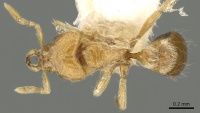Strumigenys zapyx
| Strumigenys zapyx | |
|---|---|

| |
| Scientific classification | |
| Kingdom: | Animalia |
| Phylum: | Arthropoda |
| Class: | Insecta |
| Order: | Hymenoptera |
| Family: | Formicidae |
| Subfamily: | Myrmicinae |
| Tribe: | Attini |
| Genus: | Strumigenys |
| Species: | S. zapyx |
| Binomial name | |
| Strumigenys zapyx Bolton, 2000 | |
Known from the holotype worker, nothing is known about the biology of Strumigenys zapyx.
Identification
The only member of the Strumigenys zapyx-group.
Keys including this Species
Distribution
Latitudinal Distribution Pattern
Latitudinal Range: -3.633333° to -3.633333°.
| North Temperate |
North Subtropical |
Tropical | South Subtropical |
South Temperate |
- Source: AntMaps
Distribution based on Regional Taxon Lists
Indo-Australian Region: Indonesia (type locality), Sulawesi.
Distribution based on AntMaps
Distribution based on AntWeb specimens
Check data from AntWeb
Countries Occupied
| Number of countries occupied by this species based on AntWiki Regional Taxon Lists. In general, fewer countries occupied indicates a narrower range, while more countries indicates a more widespread species. |

|
Estimated Abundance
| Relative abundance based on number of AntMaps records per species (this species within the purple bar). Fewer records (to the left) indicates a less abundant/encountered species while more records (to the right) indicates more abundant/encountered species. |

|
Biology
Castes
Nomenclature
The following information is derived from Barry Bolton's Online Catalogue of the Ants of the World.
- zapyx. Strumigenys zapyx Bolton, 2000: 916, figs. 483, 516 (w.) INDONESIA (Sulawesi).
Unless otherwise noted the text for the remainder of this section is reported from the publication that includes the original description.
Description
Worker
Holotype. TL 1.8, HL 0.42, HW 0.40, CI 95, ML 0.16, MI 38, SL 0.22, SI 55, PW 0.24, AL 0.43. Cephalic dorsum with a pair of erect hairs just behind highest point of vertex; erect hairs otherwise close to occipital margin. Promesonotal dorsum with about 8 pairs of erect simple hairs. Dorsal surfaces of middle and hind femora and tibiae each with 1-2 fine erect hairs as well as shorter ground-pilosity. Petiole node in dorsal view broader than long, its dorsum and lateral margins densely clothed with fine simple ground-pilosity. Disc of postpetiole in dorsal view with lateral spongiform lobe overlaid by fine soft hairs that radiate from lateral margins of disc. Basigastral costulae short, restricted to zone immediately behind limbus.
Type Material
Holotype worker, Indonesia: Sulawesi Utara, Dumoga-Bone N. P., 1.v.1985 (no collector’s name) (The Natural History Museum).
References
- Bolton, B. 2000. The ant tribe Dacetini. Memoirs of the American Entomological Institute. 65:1-1028. (page 916, figs. 483, 516 worker described)
References based on Global Ant Biodiversity Informatics
- Asfiya W., L. Lach, J. D. Majer, B. Heterick, and R. K. Didham. 2015. Intensive agroforestry practices negatively affect ant (Hymenoptera: Formicidae) diversity and composition in southeast Sulawesi, Indonesia. Asian Myrmecology 7: 87-104.

